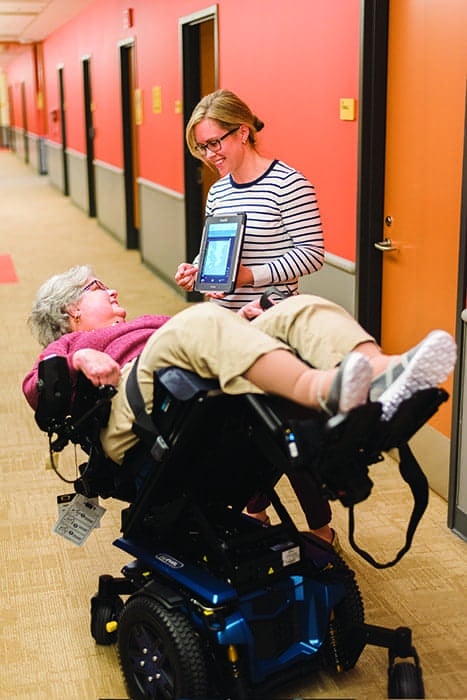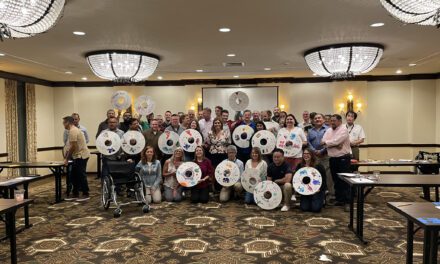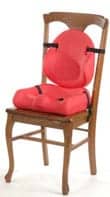
Erin Michael, PT, DPT, ATP/SMS, helps a power wheelchair user visualize pressure distribution during a seating evaluation. Michael is using a tablet-based system that provides live feedback. (Photo by Kevin Hentz Photography.)
by Erin Michael, PT, DPT, ATP/SMS, and Colleen Gillette Smith, PT, DPT, ATP
Individuals who use a wheelchair as their primary means of mobility have sitting times of more than 10 hours per day. These sitting times, in combination with reduced ability to change position and decreased sensation, put these individuals at high risk for skin breakdown. Pressure mapping is a tool for clinicians to assess pressure injury risk imposed by sitting in a wheelchair. The system measures the interface pressure between a seated client and the cushion. It utilizes sensors to identify pressures across the seating surface and create a color-coded map.1
Pressure mapping is an excellent addition to a seating clinician’s toolbox that can be used in a variety of ways. For example, it can compare seating surfaces and guide decision-making, or help identify areas of concern for breakdown. Furthermore, mapping can be used as an education tool that provides feedback about pressure-relieving strategies and activity considerations. Pressure mapping technology functions as an extension of the clinician’s hands and eyes to provide otherwise hidden information.
Evaluation Tool
There are several clinical indicators to suggest a client’s seating surface is not optimal and should be re-evaluated. A client may demonstrate abnormal posture. Poor alignment of the pelvis or the spine can lead to uneven distribution of pressure through the buttocks. They may report pain or discomfort. Another indicator would be skin changes over weight-bearing or boney areas (irritation, redness, bruising) or an open area.
First priority during the evaluation should be to ensure that the client has optimal posture and alignment. This could mean correcting flexible postures or accommodating fixed postures, with the ultimate goal of optimizing pressure distribution over the entire seating surface. In this case, the client may benefit from a positioning cushion or the addition of positioning devices.
The overall fit of the seating system should also be examined. Components that could be culprits of increased pressure include seat slope, foot rest height, backrest angle, inappropriate seat depth, or poor lower extremity alignment. In this case, modifications to the overall fit of the chair will be beneficial.
Pressure mapping can be a useful tool during evaluation. The map provides live feedback as to the overall effect on pressure distribution as modifications are made. If a client’s posture and wheelchair set-up have been optimized and they continue to demonstrate areas of high pressure, a new cushion may be considered.
Decision-Making Tool
The wheelchair cushion serves as the first line of defense against sitting-acquired pressure ulcers. There are multiple features in cushion design to be considered when making a recommendation. For instance, material directly impacts skin temperature. Recent research suggests that air-cell-based and foam cushions can increase skin temperature, as compared to fluid or fluid-foam hybrid cushions.2 Cushion shape and materials used impact how and where the buttock is loaded3 and whether the cushion works via immersion/envelopment or offloading principles. An important consideration is maintenance requirements. If the cushion is too difficult for the specific user to manage, it will not be effective.
A clinician must also weigh the pressure-relieving qualities of a cushion with its positioning capabilities to optimize pressure distribution. Traditionally, air cushions have been considered the gold standard for pressure management. However, air cushions have very low density, which can result in limitations with stability and positioning. If there is a postural abnormality, an air cushion may not be able to provide adequate correction. Also, if the user does not feel stable while in his chair, this could limit his overall function or level of independence and even limit the use of the wheelchair.
Gel cushions can offer some pressure relief as well as some postural management with the addition of extra gel unilaterally or foam wedging under the gel. However, some users with sensation find gel uncomfortable. Additionally, gel cushions tend to be heavy, which is an important consideration for the independent manual wheelchair user. Foam and honeycomb cushions offer more positioning options and stability, but tend to be less pressure-relieving.
Hybrid cushions, which combine materials, may improve outcomes. Air or gel can be utilized under boney prominences, while foam can be utilized to capture the weight-bearing portions of the pelvis and thighs for greater stability, for example.
An additional consideration would be offloading-style cushions, which utilize the principles of orthotics and prosthetics to offload at-risk bony prominences and redistribute the pressure to areas that can tolerate it. Due to the use of offloading principles, these cushions allow for stability, significant postural management, and decreased pressure risk. One small study demonstrated that these offloading cushions effectively reduced interface pressure on the boney prominences.4 Another small sample size showed lowest peak pressures on an offloading cushion, as compared to a contoured foam or air-cell cushion.3
Some clients will not show a “good” pressure map on any of the available off-the-shelf cushions. Additionally, a client may require levels of postural management that cannot be accommodated or corrected by an off-the-shelf cushion. In that case, the client may require a custom cushion or backrest.
Pressure mapping a client on multiple cushion options gives feedback about each cushion’s performance, and helps clinicians evaluate the pros and cons. Ultimately, clinicians want to find a cushion that provides adequate pressure relief while maximizing postural support and level of function, and this technology combined with a clinician’s expertise and a client’s subjective feedback, can guide the final decision.
An Educational Tool
The client is the most important player in the patient-centered model. Our most crucial role as clinicians is to educate and empower clients about their part in pressure management and skin health. Pressure mapping technology can be used as an educational tool, specifically for pressure relief and upper extremity health.
The best possible cushion and positioning is not sufficient for skin health management. The client must be able to perform adequate pressure reliefs throughout the day to permit capillary refill. This supplies the cells with nutrients and removes waste products. Without regular capillary refill, the tissues die, contributing to wound development.
A pressure relief can be performed via anterior lean, tilt, or a combination of tilt and recline. One study demonstrated that maximum pressure relief is obtained either by a full anterior lean (with chest toward thighs) or, if anterior lean is not possible, at least 65 degrees of tilt of wheelchair.5 Other studies have indicated that a combination of tilt and recline (25 or more degrees of tilt and 110 or more degrees of recline) provide the greatest load reduction.6
Research has shown that clients who use a wheelchair “push-up” for pressure reliefs are not able to maintain the position for the full 2 minutes necessary for tissue reperfusion. Furthermore, this action causes significant upper extremity strain and places the client at risk for injuries. The visual feedback of full loss of interface pressure can prove to the client the adequacy of the anterior trunk lean, making the push-up unnecessary.
With conflicting data in the research, as well as client differences, pressure mapping systems can be used to identify the optimal pressure-relieving position for each individual. The potential behavior change that could result from this education will provide protection for skin surfaces and promote shoulder, elbow, and wrist health.
Several pressure mapping systems currently on the market can help patients visualize the effects of pressure and how it relates to their seating needs. These systems use a lightweight fabric embedded with electronic sensors that conforms to the body when placed between the patient and a support surface. The sensors detect and display pressure distribution as colored areas on a grid, generally with cooler colors denoting low pressure areas and warmer colors denoting areas where loading is higher. These colorful depictions can be easily shared with the patient in real time using laptop or tablet computers, with available systems offering the option of tethered or wireless data transfer.
Pressure Mapping for All of Life
In the case of wound management or risk, it is important to remember that the cushion is not the only factor. The client’s life is multi-dimensional, and therefore the pressure concern may be multifactorial. One should also consider sleeping surface and other seating surfaces used throughout the day. Furthermore, exercises and functional activities should be considered.
Pressure mapping technology can be used to assess sleeping positions, other sitting surfaces, or while performing lower extremity ergometry or other exercises. One study found that static interface pressure mapping can be a reliable tool to use for cushion selection, even when the user is a highly active, dynamic manual wheelchair user.7 Therefore, static pressure mapping results can be extrapolated to propulsion, but not to activities that change the seating surface, body position, or the pelvic/lower extremity alignment.
Skin Health Is Multidimensional
Pressure mapping results should never be the sole basis for choosing a client’s seating surface. Additional factors to include in the decision-making process are absence or presence of sensation, subjective reports, cognition, age, tone, functional level, ability to perform independent and effective pressure reliefs, tissue thickness, and tissue compliance. Also important to consider are clothing choices, undergarments, or other additional layers between the cushion and the user. Each of these factors provides its own influence into skin health, tissue viability, and pressure ulcer risk.
Limitations of the Technology
A limitation of pressure mapping systems is that they measure only one cause of pressure wounds: normal forces. A “normal” force is defined as pressure applied perpendicular to the skin surface, a component of compression-induced ischemia.6 Two additional key components are shear forces and tissue deformation under load.
Shear forces are applied tangentially and commonly occur with friction during transfers and movement. It is generally accepted that with shear forces, only half the amount of force is required to cause ischemia and cell death, as compared to normal forces.6 Pressure mapping does not capture shear forces.
It had previously been presumed that cellular death occurs primarily from prolonged ischemia. However, recent research indicates that cellular damage can occur via tissue deformation, or change in tissue shape, alone. It takes up to 6 hours for ischemia to result in cellular damage, while it can take only minutes to hours for damage via deformation.8
Unfortunately, pressure mapping does not adequately assess deformation. Per MRI investigation, deformation response varies by cushion shape, cushion material, and the individual.8,3 Interface pressure appears to correlate with deformation, but it is non-linear. Sonnenblum found that, generally, very high interface pressure readings corresponded with higher tissue deformation.3 However, Brienza et al showed that peak pressure varied only slightly with larger levels of deformation and vice versa.8 Thus, additional research is necessary to understand the relationship between interface pressure and deformation.
Conclusion
A study by Gunningberg et al “failed to demonstrate a beneficial effect of a pressure mapping system on pressure ulcer prevalence and incidence.” However, the researchers indicated the increased awareness of pressure ulcer prevention during the study may have caused the positive effect in both the study groups.9 This demonstrates that a pressure ulcer is multifactorial and requires interventions additional to pressure mapping. While mapping is an important piece of the puzzle, it would be in great error to not consider all aspects of seating, function, and daily life for skin preservation and health.
Pressure ulcers have a significant medical, psychosocial, and emotional cost. Conversely, a well-fitted seating system pays dividends in function, comfort, and therefore quality of life. Pressure mapping systems are not able to exclusively determine answers to clinical questions, but can play a critical role in determining the best seating system for a wheelchair user. RM
Erin Michael, PT, DPT, ATP/SMS, is Manager of Patient Advocacy and Special Programs at Kennedy Krieger Institute’s International Center for Spinal Cord Injury (ICSCI) in Baltimore. She received her Doctor of Physical Therapy degree from Ithaca College in 2006. She specializes in treating paralyzing neurological conditions, including multiple sclerosis, transverse myelitis, cerebral palsy, and traumatic and non-traumatic spinal cord injury. Additionally, Michael is the coordinator of the ICSCI Seating and Mobility Clinic and has specialized in seating and mobility for nearly 10 years. She received her assistive technology professional certification in 2011 and her seating and mobility specialist certification in 2013. Michael is a member of the Clinician’s Task Force and of the RESNA Professional Standards Board.
Colleen Gillette Smith, PT, DPT, ATP, has been a physical therapist with the International Center for Spinal Cord Injury at Kennedy Krieger Institute since 2012. She completed her Doctor of Physical Therapy degree at Duke University, Durham, NC, and her bachelor of science in health sciences at Lee University, Cleveland, Tenn. She is experienced at treating patients with various neuromuscular diagnoses, with particular interests in pediatrics and seating and mobility. For more information, contact [email protected].
This article appears in the January/February 2019 issue of Rehab Management with the title, “Under Pressure.”
References
1. Stinson M, Crawford S. Wheelchair seating and pressure mapping. International Handbook of Occupational Therapy Interventions. 2014:221-231. https://doi.org/10.1007/978-3-319-08141-0_16
2. Budai M, Farrell E, Michael E. Manual wheelchair configuration and seating considerations in the spinal cord injury population. Current Physical Medicine and Rehabilitation Reports. 2018;6(3):204-211. https://doi.org/10.1007/s40141-018-0195-8
3. Sonenblum SE, Ma J, Sprigle SH, Hetzel TR, McKay Cathcart J. Measuring the impact of cushion design on buttocks tissue deformation: An MRI approach. J Tissue Viability. 2018;27(3):162-172. https://doi.org/10.1016/j.jtv.2018.04.001
4. Crane B, Wininger M, Call E. Orthotic-style off-loading wheelchair seat cushion reduces interface pressure under ischial tuberosities and sacrococcygeal regions. Arch Phys Med Rehabil. 2016;97(11):1872-1879. https://doi.org/10.1016/j.apmr.2016.04.004
5. Henderson JL, Price SH, Brandstater ME, Mandac BR. Efficacy of three measures to relieve pressure in seated persons with spinal cord injury. Arch Phys Med Rehabil. 1994;75(5):535-539.
6. Dicianno BE, Arva J, Lieberman JM, et al. RESNA position on the application of tilt, recline, and elevating legrests for wheelchairs. Assist Technol. 2009;21(1):13-22. https://doi.org/10.1080/10400430902945769
7. Hollington J, Hillman SJ. Can static interface pressure mapping be used to rank pressure-redistributing cushions for active wheelchair users? J Rehabil Res Dev. 2013;50(1):53-60. https://doi.org/10.1682/jrrd.2011.10.0192
8. Brienza D, Vallely J, Karg P, Akins J, Gefen A. An MRI investigation of the effects of user anatomy and wheelchair cushion type on tissue deformation. J Tissue Viability. 2018;27(1):42-53. https://doi.org/10.1016/j.jtv.2017.04.001
9. Gunningberg L, Sedin IM, Andersson S, Pingel R. Pressure mapping to prevent pressure ulcers in a hospital setting: A pragmatic randomised controlled trial. Int J Nurs Stud. 2017;72:53-59. https://doi.org/10.1016/j.ijnurstu.2017.04.007




